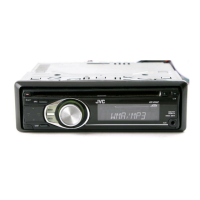
Do you have a question about the JVC KD-R302 and is the answer not in the manual?
| Tuner | AM/FM |
|---|---|
| CD Playback | Yes |
| MP3 Playback | Yes |
| WMA Playback | Yes |
| USB Port | Yes |
| Bluetooth | No |
| Aux Input | Yes |
| Display Type | LCD |
| Detachable Faceplate | Yes |
| Preset Stations | 24 (18 FM, 6 AM) |
| Remote Control | Yes |
| Channels | 4 |
| Power Output | 50W x 4 |
| Steering Wheel Control | Yes (optional adapter required) |
Safety information regarding Class 1 laser radiation and unit access.
Guidelines for environmentally responsible disposal of the product and batteries.
Instructions on how to reset the unit, which also erases preset adjustments.
Steps for forcibly ejecting a disc and handling it.
Steps for removing and attaching the control panel.
How to turn the unit on, select sources, and eject discs.
Using the control dial for volume, selection, and menu navigation.
Tuning stations, selecting tracks, and using the AUX input.
Understanding the display window and changing information shown.
Indicators for track, source, numbers, and time countdown.
Displays for disc status, sound modes, playback, EQ, and loudness.
Main display, disc info, RDS, and tuner reception status indicators.
Steps to disable the automatic display demonstration.
How to set the current time and choose between 12/24 hour format.
How display information changes for different sources and clock settings.
Auto and manual search methods for finding stations.
Adjusting settings for difficult FM stereo broadcasts.
Procedures for automatic and manual station storage.
Selecting previously stored radio stations.
Using Traffic Announcement standby reception for alerts.
Searching for radio programmes based on PTY codes.
Activating PTY standby reception for favorite programmes.
Automatic tuning to stronger signals for uninterrupted reception.
Automatic station selection based on programme type.
Inserting, playing, stopping, and ejecting discs.
How to prevent a disc from being ejected.
Navigating and selecting tracks or folders on MP3/WMA discs.
Choosing playback modes like Repeat, Folder Repeat, and Random.
Steps to connect and play audio from external components.
Adjusting volume and input levels for external sources.
Choosing sound modes like Classic, Rock, Pops, etc.
Storing and adjusting custom EQ settings for Bass and Treble.
Configuring display demonstration and clock settings.
Adjusting equalizer presets and display dimmer.
Managing display scrolling and MP3/WMA tag information.
Configuring alternative frequency and regional reception.
Managing PTY standby and traffic announcement volume.
Adjusting monaural mode and intermediate frequency band.
Selecting preset or user-defined display and button colors.
Adjusting fader, balance, and loudness settings.
Configuring auxiliary input levels, keypress tones, and tel muting.
Setting amplifier gain and managing source selection availability.
Steps to create custom DAY and NIGHT colors.
Setting the level for selected primary colors (Red, Green, Blue).
Extended information on turning the unit on/off and source switching.
Details on Network-Tracking and TA Standby Reception.
Cautions regarding DualDisc playback and general disc compatibility.
Guidelines and precautions for playing recordable and rewritable CDs.
Requirements and limitations for playing MP3 and WMA files.
Information on disc ejection timing and AMP GAIN menu effects.
Solutions for no sound, unit not working, or dim display.
Fixes for SSM presetting, static noise, and source selection problems.
Resolving issues with disc playback, ejection, and interruptions.
Troubleshooting for non-playable discs and generated noise.
Addressing issues with track playback order and character display.
Instructions for cleaning unit connectors and keeping discs clean.
Handling moisture condensation on the unit's lens.
Proper methods for handling, playing new, and storing discs.
Details on power output, impedance, tone control, and frequency response.
Specifications for FM, MW, and LW tuner sensitivity and selectivity.
Details on CD player type, signal detection, channels, and frequency response.
Information on power requirements, operating temperature, dimensions, and mass.
Guidance on how to reset the unit when experiencing operation problems.
